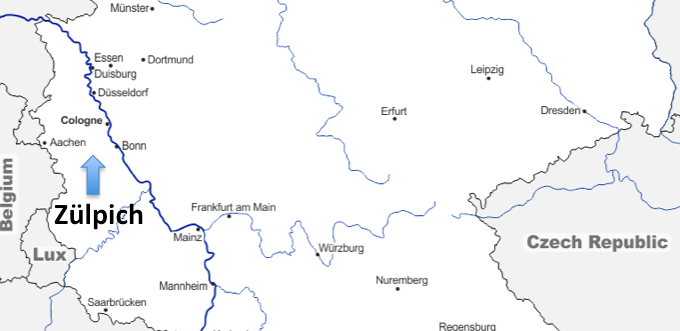
A European Journey #35 – Zülpich (Germany)
In this episode we will finish this miniseries of five stages in which we have visited some of the places showing how European pagan tribes turned to Christianity.
And for the final stage of this series, we will visit Zülpich, a town locatedin the region of North-Rhine Westphalia in Germany, nearly 50 km Southeast from Aachen and 40 km Southwest from Cologne.
This is a town of roughly twenty thousand inhabitants. And the most prominent sight to visit here is a fourteenth century castle, which stands as a reminderof the Holy Roman Empire. Nowadays it serves as a tourist information centre and as the seat of the Zülpich History Society.
But today, we will go outside the old town and go westward along a road going through the fields and passing througha hamlet called Langendorf. After the hamlet there isa low hill covered with trees on the right side of the road. There we turn to follow a footpath into the woods.
These woods and the fields around may seem insignificant. And yet, very probably they were the stage of one of the most significant battles in West-European history.
The battle we are talking about took place sometime between the end of the fifth and the beginning of the sixth century. The town of Zülpich already existed then. It was previously a Roman colony called Tolbiacum. And so, the battle we are talking about is the Battle of Tolbiac.
This battle involved one of the most famous kings of Western medieval history, Clovis I. In his time, the Western Roman Empire was nearly totally dismantled because of the invasion of the Germanic tribes during ‘The Great Migration’. Clovis himself was a member of a specific tribe, the Franks. At a very young age, he became the king of the Salian Franks, a small kingdom located between the rivers Scheldt and Meuse situated within modern-day Belgium.
As we have seen in previous stages, the Germanic tribes were either pagan or Arian (a Christian heresy). Clovis himself was pagan, and like most Germanic rulers of his time, he wasalso a ferocious warrior. He fought and won his first significant battle as a young adult against the neighbouring Southern kingdom of Soissons or Syagrius, which was the last remnant of the Roman Empire in Gaul.
After that Clovis intended to marry a lady called Clotilda. She was the daughter of the king of the Burgundians, a tribe that had settled in modern-day French Burgundy and Swiss Romandy. While Clotilda’s family was Arian, she became Catholic, which meant that she believed that Jesus was God, according to the Nicene Creed. So when Clovis proposed to her, she accepted with the condition that she would be able to continue practicing her faith. Clovis agreed to this.
After they got married, Clotilda aimed to bring her pagan husband to the knowledge of Christ. However, Clovis didn’t seem very interested. Circumstances didn’t seem to work in their favour either. His first son died at an early age shortly after having been baptised and Clovis concluded that it was because he had angered his gods with the baptism. But then when their second baby was sick and approaching death, Clotilda prayed and the baby was miraculously healed. But this did not seem to have an impact on Clovis.
But then came the battle of Tolbiac. This time, the opponent was another Germanic tribe, the Alemanni, who were threatening the Frankish kingdom. Clovis naturally defended his kingdom against their invasion.
The battle was rather difficultfor Clovis who was losing many of his soldiers. As he realised that his prayers to his pagan gods didn’t seem to work as well as in previous battles, Clovis invoked the God of Clotilda, and promised him that in case of victory, he would renounce his gods and be baptized in the faith of his wife. This is when the battle took a different turn, and Clovis won. Finally he respected his promise and was baptized in Reims.
The conversion of Clovis made his realm the first Germanic kingdom in Western Europe to embrace the Nicene Creed. Later on, Clovis won other significant battles against tribes such as the Visigoths and the Burgundies. Finally the little Salian Frank kingdom became the powerful Austrasian Empire, where the official religion was obviously Catholicism. Clovis donated lands and wealth for the building of churches and monasteries. This allowed the Christian faith to take root among the Franks and the subdued tribes. Moreover, this laid the foundation for organised community life in the Empire.
Sad to say, this growth of wealth coincided with a loss of holiness in the Church. There was little concernfor mission among other tribes and the subsequent generations in the empire began to abandon the faith.
But fortunately, this is when a new wave of missions from the Celtic monks coming from the British Isles began to impact the Germanic tribes of Europe, which will be, God willing, the subject of another series of A European Journey.
See you next week somewhere else in Europe.
Cédric Placentino
Schuman Centre convener for Italian and French Europe
Follow A European Journey here.

This Post Has 0 Comments